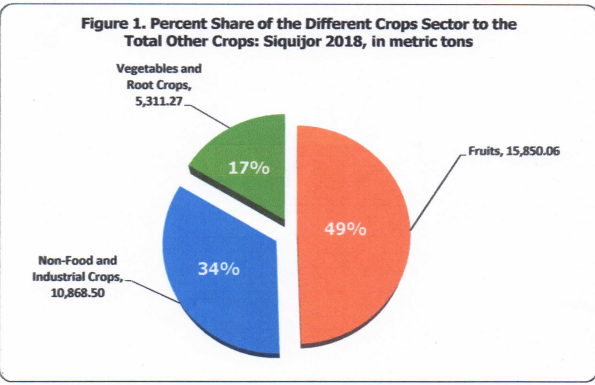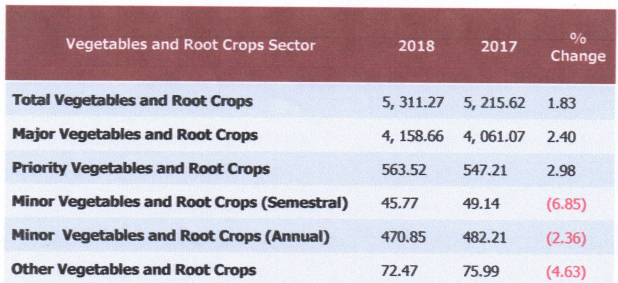OTHER CROPS SITUATIONER 2018
The total production of other crops in the province was estimated at 32, 029.84 metric tons in 2018. It surpassed by 62.94 metric tons from 2017 record of 31,966.90 metric tons. Fruits sector had the biggest share of 15, 850.06 metric tons. It was followed by Non-Food and Industrial Crops sector with a production share of 10,868.50 metric tons and Vegetables and Root Crops sector with 5,311.27 metric tons production share.

Vegetables sector triggered the overall increase in production of other crops in the province bearing 1.83 percent increment. Its production in 2017 was only 5,215.62 metric tons and it moved up to 5,311.27 metric tons in 2018.
However, a downward trend was observed on fruits sector with a production estimate of 15,850.06 metric tons in 2018 from 15,866.98 metric tons in 2017. Non-food and industrial crops sector also registered a downward trend with a production loss of 0.15 percent, or from 2017 its record was 10,884.30 metric tons and it went down to 10,868.50 metric tons in 2018.
Table1. Other Crops Production by Sector, Siquijor: 2018 vs 2017, in metric tons

FRUITS PRODUCTION MOVES DOWN IN 2018
The total fruits production in the province of Siquijor was estimated at 15,850.06 metric tons in 2018. It was down by 0.11 percent from its record in 2017 of 15,866.98 metric tons. The downward trend was noted in major, priority and minor (semestral) fruits with production decreases of 0.02 percent, 2.35 percent and 2.94 percent, respectively.
However, production of minor (annual) and other fruits registered positive changes over 2017. Minor fruits increased from 34.13 metric tons in 2017 to 34.53 metric tons in 2018, while other fruits increased from 2.85 metric tons in 2017 to 6.10 metric tons in 2018. (See Table 2).
Table 2. Fruits Production by Sub-Sector, Siquijor: 2018 vs 2017, in metric tons.

NON-FOOD AND INDUSTRIAL CROPS DECLINES IN 2018
Non-Food and Industrial Crops (NFICs) was down by 0.15 percent in 2018 compared to 2017. Its production was recorded at 10,868.50 metric tons and was lower than last year’s record of 10, 884.30 metric tons. Priority NFICs pulled down its overall decrease as it posted a decrement of 26.49 metric tons.
All other sub-sectors of NFICs showed positive trends in production but of minimal amount only. Major NFICs increased by 0.04 percent, Minor NFICs (Semestral) increased by 3.82 percent, Minor NFICs (Annual) increased by 8.33 percent and Other NFICs increased by 2.55 percent in 2018 compared to its record in 2017.
Table 3. Non-Food and Industrial Crops (NFICs) Production by Sub-Sector, Siquijor: 2018 vs 2017, in metric tons

VEGETABLES AND ROOT CROPS INCREASES BY 1.83 PERCENT IN 2018
Production on Vegetables and Root Crops in Siquijor marked at 5, 311.27 metric tons in 2018. It was 1.83 percent higher than its record in 2017 of 5,215.62 metric tons. The production increment was contributed by Major and Priority vegetables and root crops. Major vegetables and root crops increased from 4,061.07 metric tons in 2017 to 4,158.66 metric tons in 2018. Priority vegetables and root crops likewise moved up from 547.21 metric tons in 2017 to 563.52 metric tons in 2018.
Meanwhile, Minor (Semestral and Annual) vegetables and root crops both showed negative trends in production in 2018 compared to its record in 2017. A 6.85 production decrement was noted on Semestral Minor vegetables and root crops, while a 2.36 production decrement was reported on Annual Minor vegetables and root crops. Furthermore, other vegetables and root crops recorded a production of 72.47 metric tons, a decrease by 4.63 percent from its record in 2017 of 75.99 metric tons.
Table 4. Vegetables and Root Crops Production by Sub-Sector, Siquijor: 2018 vs 2017, in metric tons.

TECHNICAL NOTES ON CONCEPTS AND DEFINITIONS
Crop Production is the quantity produced and actually harvested for a particular crop during the reference period. It includes those harvested but damaged, stolen, given away, consumed, given as harvesters' and threshers' shares, reserved etc. Excluded are those produced but not harvested due to low price, lack of demand and force majeure or fortuitous events, etc.
Industrial Crops are crops that are used as inputs to other industries.
Major Crops refers to the top 19 crops in the Philippines, other than palay and corn which collectively account for more than 60 percent of the total volume of crop production. These include coconut, sugarcane, banana, pineapple, coffee, mango, tobacco, abaca, peanut, mongo, cassava, sweet potato, tomato, garlic, onion, cabbage, eggplant, calamansi and rubber
Minor Crops are all the remaining crops other than the major crops. This group accounts for about 40 percent of the total crop production. Non-Food Crops are crops other than those used for food consumption. These are crops grown for their aesthetic values such as ornamental plants and cut-flowers. These also include agriculture-derived products such as rice hay and coconut leaves.
Priority Crops is the identified national banner crops and various regional priority crops of the then Key Commercial Crops Development Program (KCCDP), now High Value Crops Development Program (HVCDP) and crops under the Key Commodity Road Maps of the Department of Agriculture, which are being developed because of their industrial and commercial potentials.
(SGD.) AURELIA M. CANDA
Chief Statistical Specialist

